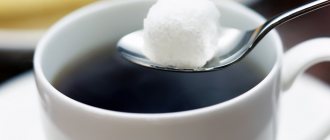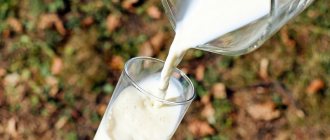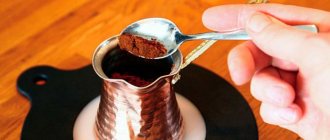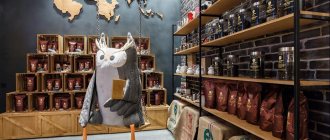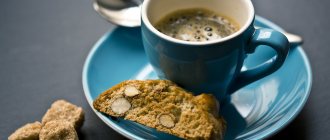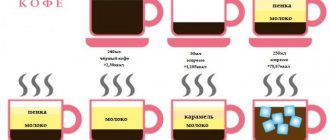In the instructions on the packaging of coffee from the manufacturers they write that preparation requires 1-2 teaspoons of coffee, which need to be poured with boiling water,” others indicate how many grams to take for one cup of drink.
At the same time, sometimes it is not indicated which ground coffee is intended for which cup (volume).
The tables are sometimes silent about which cup is meant: is it a professional espresso cup with a volume of 40 ml, or is it a mug with a volume of 300 ml.
For example, for a standard cup of espresso (35-40 ml volume), you need 7 grams of coffee with a finer grind than average. Only this ratio gives a truly tasty and aromatic drink.
But how to measure such an amount if there are no accurate mini-scales? Therefore, we need to find out the volume of the ordinary teaspoon and tablespoon we know.
How much coffee can be held in spoons: tea and table spoons
We all know that coffee is poured into spoons with or without a slide. Sometimes recipes do not indicate the quantity with or without a heap. The capacity of spoons with these nuances you just need to remember:
- Ground coffee: 1 tbsp. without slide - approximately 12 grams. With a slide - 18 grams.
- Ground coffee: 1 tsp. without a slide - approximately 4 grams. With a slide - 6 grams.
- Ground coffee: level coffee spoon – 2 grams. With a slide - 3 grams.
- Freeze-dried instant coffee: 1 tsp. without a slide – 2 grams. With a slide - 2.5 grams.
- Freeze-dried instant coffee: level coffee spoon – 1.5 grams. With a slide - 2 grams.
- Powdered instant coffee: 1 tsp. without slide – 3 grams. With a slide - 3.5 grams.
- Coffee beans: 1 tsp. – 4.5 grams. 1 tbsp. – 10-11 g,
- 1 coffee spoon – 3.5 grams.
1 tablespoon of beans yields 7 grams of ground coffee.
The calculation is that for 200 ml of water you will need approximately 40 grains. A cup of coffee requires 85 grams of coffee beans.
Table etiquette
A few words also need to be said about how correctly a coffee spoon should be served, in other words, how it should be positioned if you want to treat your loved one to coffee in all its nuances. It is important to remember that a cup of hot drink is almost always served on a saucer. The handle of the cup should look to the right and certainly be parallel to the table. A likely option is when dark coffee is served without grounds, in which case the handle of the cup may look to the left (certainly parallel to the table). But with all this, the coffee spoon always retains its standard position: it is placed behind the cup with the handle to the right of the person who will enjoy the fragrant drink.
Not all spoons are the same
The shape and volume of spoons are different. Teaspoons are made with deviations of +/- 1 ml, tablespoons with deviations of +3 or -2 ml. Tablespoons are typically made with a volume of no more than 18 ml.
It should be taken into account that in Western countries and former USSR countries the standards for the volume of spoons do not coincide. In the West, the volume is 15 ml, while in the USSR it is 18 ml.
When they write “one teaspoon” and “one tablespoon” in recipes, we mean with a heap, there – without a heap.
A number of assistants for dosing various ingredients, including coffee, will help simplify weight measurement without scales. This is a set of measuring spoons. In addition, you can buy sets of spoons online that are made according to American, Australian or British measures that differ from our usual ones.
Production material
What materials can a coffee spoon be made from? In most cases, these are stainless steel, precious metals (gold, silver, aluminum). As a gift option, coffee spoons are carved from wood. The walking standard is made of plastic. But manufacturers make cutlery from metal compositions: silver - gold, stainless steel - honey alloy. It is also worth mentioning that on sale you can see different gift options for coffee spoons: made of high-quality metal and in beautiful packaging. Another interesting fact is that it is customary for small children to be given tiny spoons for their first tooth or at birth. It’s great if it’s not a teaspoon, but still a coffee spoon. After all, it may turn out to be the baby’s first eating device at the time of introducing complementary foods, since it has a small, just suitable volume.
The weight of coffee in a spoon depends on the grind
The weight of coffee varies depending on the degree of grind. The smaller the particles, the more can be placed in the spoon and, accordingly, the weight, and vice versa. The difference is approximately 2 grams.
The larger the fraction, the less the spoon can hold, and accordingly the weight will also be less.
The grinding used for drinks in different coffee makers varies. In this case, we consider a standard cup to be 200 ml of drink.
- Drip coffee maker – 14 grams;
- French press or brew in a cup – 16 grams;
- Cezve – 25 grams;
- Geyser-type coffee maker – 35 grams;
Small conclusion
Now, if our readers have a teaspoon and a coffee spoon in front of them, no questions will arise. After all, it is now as clear as possible how these cutlery items differ: size and purpose. If, after everything you’ve read, it’s still unclear to you what a coffee spoon looks like, a photo is the first assistant in this matter. So, for convenience, it is better to look at our photos to see how a coffee spoon looks compared to a tea spoon, and draw certain conclusions for yourself. With all this, it is worth mentioning that for some people it is bad form when serving teaspoons with coffee. After reading our article, you can really avoid uncomfortable situations without any problems. After all, we informed you about everything.
Determine the weight of citric acid: how many grams are in a teaspoon?
Citric acid is one of the most common food additives used today. It is made from natural raw materials and is intensively used in cooking: it is added to drinks, mousses, sauces, soups, desserts and marinades for meat. This is a good preservative that allows you to increase the shelf life of fish, meat, vegetables, mushrooms, and fruits.
Citric acid is used in medicine, cosmetology, winemaking, and even for household purposes: it softens very hard water, cleans the surface of dishes and plumbing fixtures from dirt.
Grinding degree for different devices
- into the dust (the finest) - Turkish coffee or oriental coffee (in cezve, Turk);
- fine – espresso (in espresso coffee machines);
- medium – mocha, filter coffee (in a drip coffee maker, AeroPress), capsule coffee;
- large - in a French press, percolator.
When you need to prepare many servings of coffee at one time, for example in a drip coffee maker, it is more convenient to measure the amount of ground coffee with a tablespoon. In the case of espresso or Turkish coffee in a cezve, it is better to take a teaspoon.
Purpose
It is very important to know how and when to serve a coffee spoon and when to serve a teaspoon. So, the names themselves already say a lot: when drinking tea, you need to put teaspoons on the table, but according to all the nuances of table etiquette, you need to serve coffee with small spoons.
It is important to remember that coffee spoons have different handle lengths. After all, for example, if a guest wants to drink iced coffee or Irish coffee, which is served in large glasses, then for this he needs to take a coffee spoon with a rather long handle. Otherwise, the unique table device will dive completely into the cup of drink.
Coffee machine: how many grams of coffee should I put in?
In an automatic coffee machine with a bean grinding function, the weight of the ground coffee (number of beans) for one-time filling of the portafilter (one grind) depends on:
- from the “fortress” settings;
- from the program used;
- coffee maker design.
The strength ranges from 1 to 12. Each establishment usually uses no more than 2 types of devices. All coffee machines have an automatic adjustment that makes adjustments +/- grams.
Below is a table of values for known models:
These are theoretical values, but real numbers differ depending on the beans, grinding, and adjustment system.
To find out the amount of beans to grind at each strength of an automatic coffee machine, you need to divide the difference in values (maximum-minimum) by the “number of degrees of strength minus one” and you can get the step of each degree.
For example, let's assume a coffee machine with 5 strength levels. The difference in values is 4 (11 - 7) grams. “The number of degrees of strength minus one” is equal to 4 (5 - 1). 4/4= 1 gram. This is the step of the fortress.
The minimum, that is, the first degree is 7 grams, the second degree is 8 grams, the third degree is 9 grams, the fourth degree is 10 grams, the fifth, maximum degree of strength is 11 grams.
What are the proportions of coffee and water?
And, of course, the proportions of coffee and water are very important. The correct ones are: 1-2 teaspoons of freshly ground grains per 180 ml of water. The drink should be thick, aromatic and slightly bitter. These are general rules.
Interesting materials:
What can you carry in your luggage on a plane? What can you carry in your hand luggage? What can you bring across the border? What can you bring across the Hungarian border? What can you transport from Finland to Russia? What can you carry on board an airplane? What can you bring to Israel by plane? What food items can you bring on a plane to Israel? What can you put on a slide? What can you eat after training before bed?
How many grams of coffee are in a measuring spoon of coffee machines included?
All automatic grain coffee machines are equipped with a measuring spoon included. Different brands have different shaped scoops. However, they all have the same capacity of ground coffee - 8-9 (some say 7) grams.
One scoop on average equals 2 tablespoons. To get a strong cup of drink you will need one scoop per cup.
However, these figures are approximate compared to a teaspoon or tablespoon.
Firstly, this capacity is without a slide; when using it, a person necessarily adds a couple of grams on top.
Secondly, grade and grind affect grams. Store-bought packaging of ground coffee has an uneven grind and a person with his own measuring spoon included in the device will no longer be able to influence the degree of grinding. But in any case, you need to focus on these 8-9 grams.
Use a measuring device
To avoid confusion when calculating the volume of crushed grains in a spoon, we recommend using a standard measuring device. It comes complete with coffee makers and coffee machines.
The volume of this spoon is 7 g.
If you don’t plan to buy a coffee machine, you can purchase a meter at kitchen supply stores. The cost depends on the brand and material. The price starts from 100 rubles.
Baristas recommend a non-standard way to measure the mass of ground beans. Take a matchbox and fill it to the brim. It will turn out to be exactly 7 g.
Table
| Gram of ground coffee | Number of tablespoons | With a slide |
| 12 grams | 1 | 0.71 |
| 24 grams | 2 | 1.41 |
| 30 grams | 2.5 | 1.76 |
| 35 grams | 2.92 | 2.06 |
| 40 grams | 3.33 | 2.35 |
| 45 grams | 3.75 | 2.65 |
| 50 grams | 4.17 | 2.94 |
| 55 grams | 4.58 | 3.24 |
| 60 grams | 5 | 3.53 |
| 65 grams | 5.42 | 3.82 |
| 70 grams | 5.83 | 4.12 |
| 75 grams | 6.25 | 4.41 |
| 80 grams | 6.67 | 4.71 |
| 90 grams | 7.5 | 5.29 |
| 100g | 8.33 | 5.88 |
| 150 grams | 12.5 | 8.82 |
| 200 grams | 16.67 | 11.76 |
| 250 grams | 20.83 | 14.71 |
| 300 grams | 25 | 17.65 |
| 400 grams | 33.33 | 23.53 |
| 500 grams | 41.67 | 29.41 |
| 600 grams | 50 | 35.29 |
| 700 grams | 58.33 | 41.18 |
| 800 grams | 66.67 | 47.06 |
Similar calculators:
Let's talk about how much coffee is in 1 teaspoon. Aromatic, invigorating espresso will only be achieved if the proportions are strictly observed. Ground or whole coffee berries are supplied to the market, as well as granulated, freeze-dried and powdered forms of instant product. Each of them has its own consistency, which affects the mass. The weight also depends on the degree of grinding. Experienced baristas measure coffee in grams and determine the required amount by eye. But it's much easier to count in spoons.
